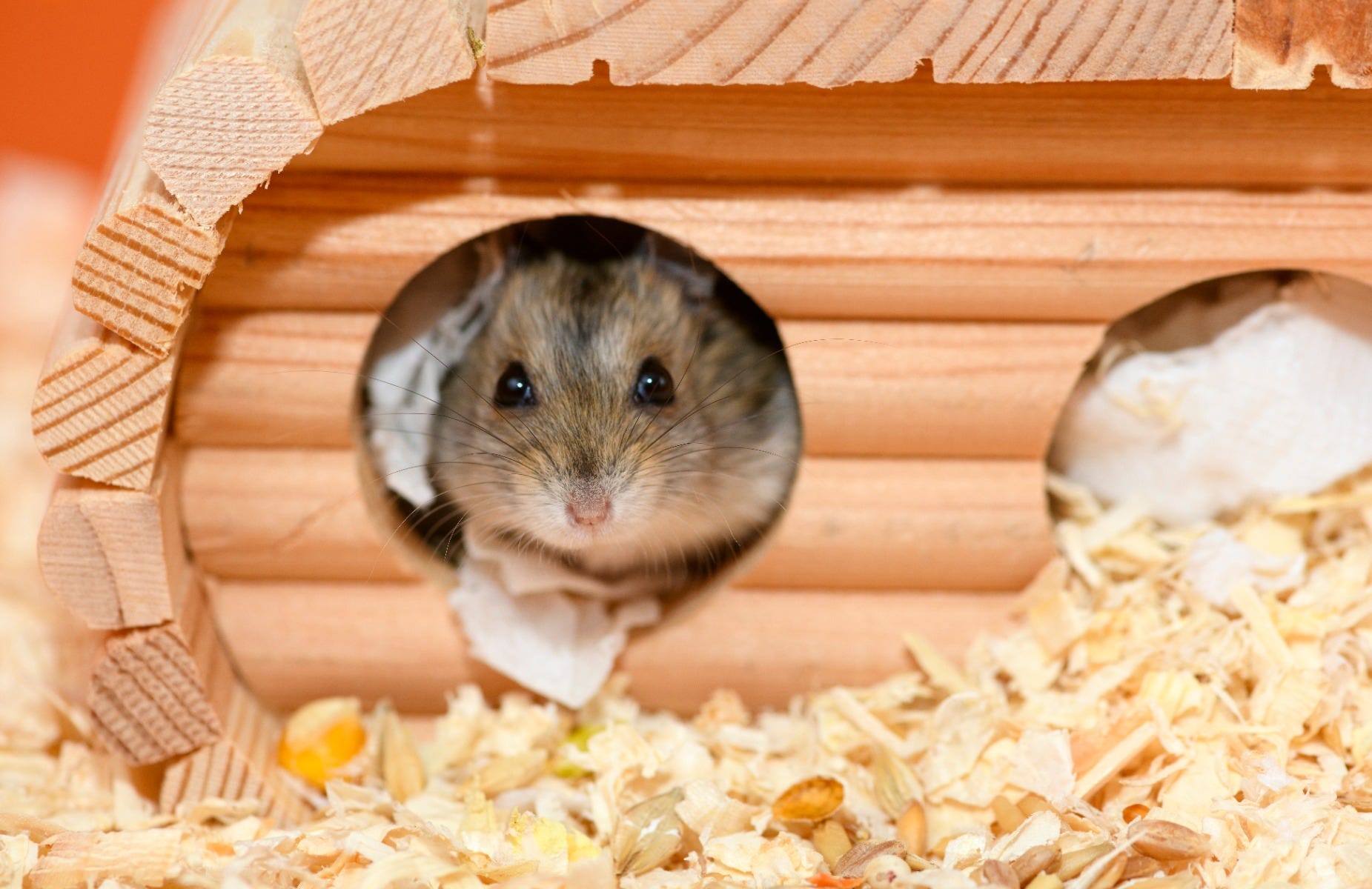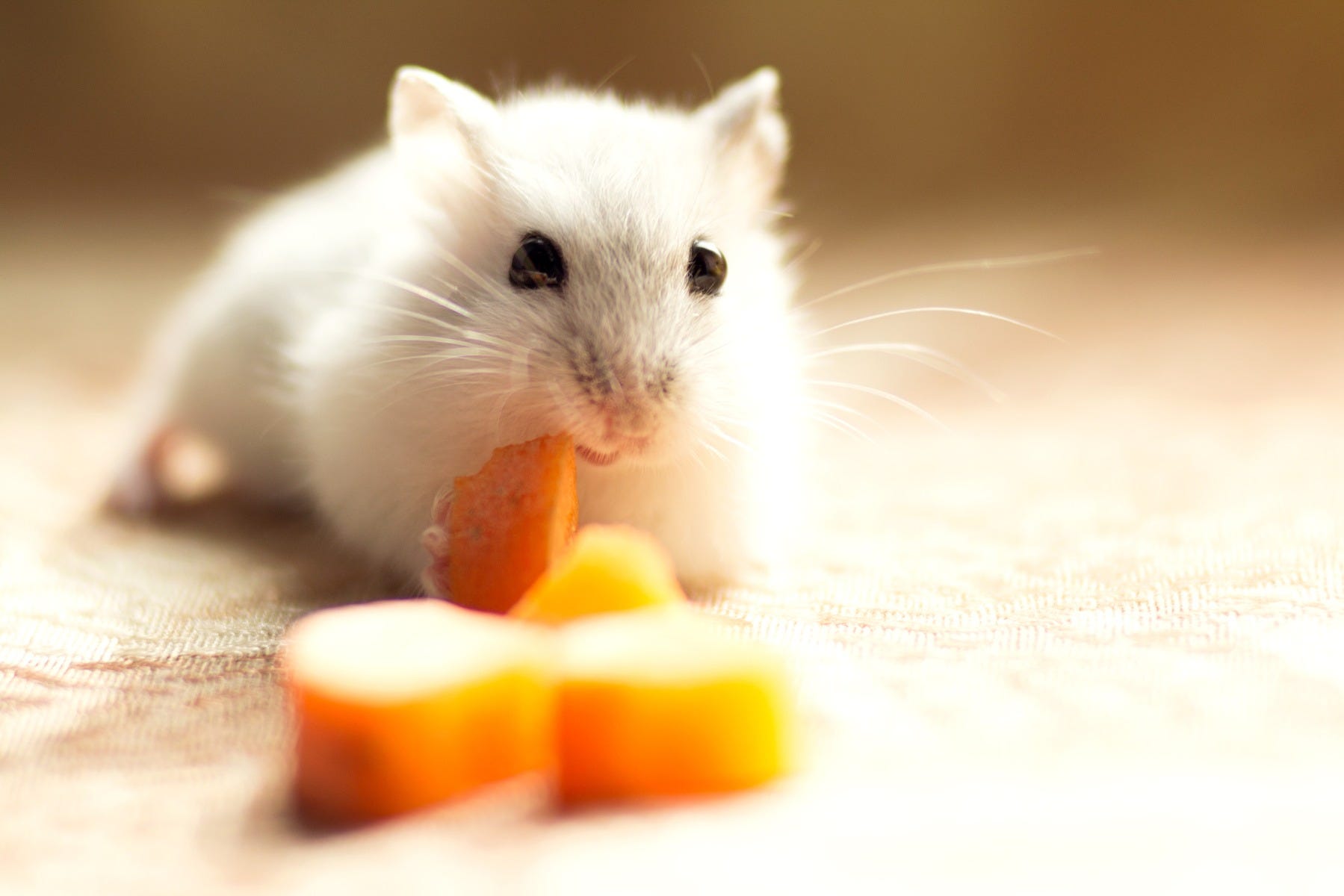The Beginners Guide to Hamster Care
Did you know that hamsters are the 7th favourite pet in the entirety of the UK, with over 600,000 being kept as pets?
With the right care and attention, hamsters can make adorable and fulfilling pets, but sadly not many people know how to properly meet the nutritional and spacial requirements a hamster needs to thrive. This is where we come in. We'll tell you all about keeping a hamster, from what hamsters eat to finding the best hamster cage so you can give your little friend all the love and attention they need.
Content:
Things to Consider Before Getting a Hamster
Before you look into how to care for a hamster, there are some things to consider. Even though they’re small, hamsters still require the same level of care and commitment as any other pet, including ensuring all their needs are being met, from food to healthcare.
- Cost — Hamsters are popular pets because they’re small and relatively easy to care for, but that doesn’t mean they’re cheap. While a hamster itself may not cost more than £10 - £20, buying all the required equipment, food, and bedding can quickly add up. Plus, you’ll need to pay for any healthcare needs during your hamster’s life as well, and finding a vet willing and able to treat a hamster can be a challenge.
- Space — Another reason why hamsters are popular pets is that people believe they don’t need much space. However, hamsters are very active animals who love to explore and burrow, so ensuring they have the proper space to do so, in or outside of their cage, is an essential part of responsible hamster ownership.
- Research — No matter what pet you’re choosing to get, it’s crucial you do your research and understand the basic needs of the animal before you consider bringing one home. This includes knowing what they need to eat, how much space they need, and the natural behaviour of the animal in the wild.
How Long Do Hamsters Live?
It’s difficult to give a definitive answer as to the lifespan of a hamster as there are over 24 different species. Generally speaking, a healthy hamster can usually live for up to two years, although some may live for more.
Types of Hamsters
Before getting a pet hamster, it’s important to research what kind of hamsters are available as pets, as they vary greatly in size and temperament. Which hamster works for you will depend on the space you have for their enclosure and how much you can spend on food and their other requirements:
Syrian Hamster
Perhaps the most popular breed of hamster is the Syrian Hamster, also known as the golden hamster. These hamsters grow to between 6-8 inches long (14-19cm) and tend to weigh around 110-140g.
Despite being known as Golden hamsters, Syrian hamsters are actually available in a wide variety of colours, from all white to all black, and some even have spots or patterns.
Syrian Hamsters are extremely territorial and need to live alone once they mature fully.

Russian Dwarf Hamster
Another popular choice for a pet hamster is a Russian Dwarf Hamster, a considerably smaller cousin to the Syrian Hamster. These hamsters tend to grow to around 3-4 inches long (7-10cm) and weigh between 19-45g.
These hamsters vary in colour from beige to brown, black or white. While some Russian Dwarf hamsters can live together if they’ve been housed together since birth, they still might become territorial, so it’s usually best to house them alone unless you’re an experienced hamster owner.

Roborovski Hamster
The third most popular breed of hamster also happens to be the smallest. The Roborovski Hamster tend to grow to around 1-2 inches (4-5cm) long and weigh between 20-25g. These tiny little guys tend to be a sandy colour with white bellies and eyebrows.
Because of their size, Robo hamsters can be hard to handle until they get used to you and your presence, and it may take some time for you to build that bond.

Do Hamsters Make Good Pets?
As with any other animal, the suitability of a hamster depends on your own lifestyle. For many people, hamsters make brilliant pets because they’re relatively low maintenance and don’t need as much attention. This also makes them popular first pets for children.
Some important things to note about hamsters are:
- Hamsters are nocturnal — This means they are asleep during the day and tend to wake up in the evening and into the night.
- Most Hamsters have to live alone — Unlike other small pets like guinea pigs or rabbits, hamsters are best kept alone once they’re grown and may some hamsters may fight each other in kept in the same enclosure.
- Hamsters are prey animals — As such, many hamsters can become stressed simply by the presence of another animal in the home.
- Many hamsters don’t like being held — Cute and fluffy as they are, hamsters are still prey animals. Their instinct is to be afraid or wary of anything bigger than them. This means that some hamsters become stressed or scared by being held and may bite you to try and get away.
If any of these aspects don’t appeal to you, then a hamster may not be the ideal pet for you. However, if you still think a hamster might be the right choice for you, then read on to find out how to properly care for your hamster.
The Basics of How to Look After a Pet Hamster
If you've considered all the aspects of hamster care and still think they'll make the perfect addition to your family, then now is the time to learn how to care for them. Here, we cover all the basics of hamster care, from what to feed your hamster to what enclosures are suitable.

Enclosure
Even though they’re small, hamsters are active animals, so the more space you can give them, the better. The minimum requirement for a hamster cage is H20 x W30 x L20 inches (H50 x W80 x L50cm), no matter what breed of hamster you are keeping in it. Many of the hamster cages you see in pet shops (particularly novelty cages designed for children to enjoy) are far too small to keep a young dwarf hamster in, let alone a grown Syrian Hamster.
Hamsters love to burrow and build their nests in the wild, and you must allow your pet hamsters to exhibit the same behaviour in their cage. The base of your hamster’s cage should have at least 6 - 10 inches of bedding where they can burrow down and make their nests.
The best bedding for hamsters is anything that is dust-extracted, as the dust found in most wood shavings or sawdust can be bad for your hamster’s small respiratory system. If you want to use wood-based bedding, it’s recommended you use Aspen bedding as it’s low dust and very absorbent, so is better at controlling odours.
Paper-based beddings are also a popular choice for hamster cages as they’re soft and absorbent and also come in a wide variety of colours. However, some paper beddings are too soft and delicate to provide proper burrow and tunnelling space, so it’s best to include some tunnel structures under the bedding for your hamster to use.
Your hamster's enclosure should also contain a range of toys, hideaways and an exercise wheel to get the right amount of exercise and stimulation throughout the day.
You should clean your hamster’s enclosure regularly, especially in the spots where they urinate, to prevent bacteria and odour from spreading.

Diet
Hamsters are omnivorous, which means they don’t only eat fruit and vegetables, but also grains and meat like mealworms or other bugs. The base of your hamster's diet should consist of a complete hamster food packed with all the necessary nutrients your hamster needs, such as the Science Selective Hamster Food. The amount of this food you should give your hamster will depend on their size and breed, but the recommended amount will be listed on the product packaging.
As well as this, you should also give your hamster small portions of fruit or vegetables (such as Carrot, broccoli, cabbage, and cauliflower) every day, as well as occasional hamster treats, either store-bought or you can offer small portions of the following:
- Nuts
- Boiled egg
- Mealworms
As hamsters spend a lot of their time in the wild foraging for their food, you can make mealtimes more interesting for your hamster by encouraging this behaviour by scatter feeding. This involves scattering your hamster's pellets and other foods around their cage instead of feeding them from a bowl to encourage natural foraging behaviour.
You can also try hiding food and treats inside cardboard tubes, boxes, or hamster toys so they can enjoy searching for the food and keep them mentally stimulated.
Your hamster must always have access to fresh, clean water, either in a small water bowl or in a water bottle suitable for a hamster. Your hamster's food and water should be changed daily, and any uneaten fruit or vegetables should be removed from their cage to prevent attracting flies or other parasites.
Muesli Hamster Food
A lot of popular pet shops and small animal food brands offer a muesli mix for hamsters and other small pets, but it’s recommended you don’t feed this to your hamster. This is because they tend to pick and choose which parts of the muesli they eat, often leaving behind parts containing vital nutrients.
Health
Hamsters need healthcare just like any other animal, and it’s your responsibility as their owner to ensure they are happy and healthy. It’s recommended you perform a health check on your hamster at home once a week to check the following:
- Teeth — Hamsters, like rabbits and other rodents, have hypsodont teeth, which means they never stop growing. Hamsters need plenty of things to gnaw, like hamster toys and gnaw sticks, to keep their teeth the right length.
- Skin & Fur — Your hamster’s fur should be clean and dry all over with no signs of scabs or missing hair anywhere. Run your fingers along your hamster’s body to feel for any lumps and ensure they’re parasite-free.
- Eyes & Ears — Check your hamster’s eyes are bright and alert with no visible discharge and that their ears and clean and have no scabs.
- Bottom — Make sure their rear end is clean and dry with nothing stuck to them and no staining.
- Breathing — Hamsters have delicate respiratory systems, and things such as dust can easily cause irritation. Make sure your hamster is breathing steadily and that their ribcage is moving freely. You shouldn’t be able to hear your hamster when they’re breathing.
Common Illnesses in Hamsters
There are a few illnesses that hamsters may be prone to throughout their lives, especially when they’re not receiving the proper care. These include:
- Impacted Cheek Pouches — this occurs when a hamster has lodged food in their cheek pouches and can’t get it out again. If left too long, this can lead to an infection, or sharp food may pierce through your hamster's cheek pouch.
- Wet Tail (Diarrhoea) — This kind of diarrhoea in hamsters is associated with stress, especially when first bringing a hamster home for the first time.
- Skin Conditions — Mites and ringworm are two parasites that can cause skin conditions in hamsters. Look for any red, itchy skin or scabbing on your hamster.
- Injury — Hamsters are very short-sighted, especially those with red eyes, so maintaining their eye health is essential. Because of their poor eyesight, they also have poor depth perception and can often fall off the edges of tables and injure themselves. Always supervise your hamster closely when they’re not in their cage, and make sure they have plenty of ladders or ramps to manoeuvre levels inside their cage.
If your hamster ever experiences any of the above conditions, consult your vet as soon as possible for treatment.

Handling
As we’ve mentioned above, hamsters are prey animals, and due to their size, some of them may not like being handled often, if at all. This can be frustrating if you were hoping for a cuddly little friend, but it’s in their nature. Whether or not your hamster enjoys being handled will depend on their individual temperament, but you can sometimes gradually build a bond with your hamster, which results in them being happy to be handled.
Here are some tips on how to handle your hamster:
- Make sure they are awake and alert. Disturbing a hamster while they’re sleeping can scare them.
- Place your hand gently inside their cage. This allows them to get used to your scent and presence.
- Gently stroke them with your finger and see how they respond. Don’t be alarmed if you feel them nip you. Hamsters test new things with their teeth, and moving too quickly might startle them.
- When picking up your hamster, do so by cupping your hands on either side of their body and gently scooping them up.
- Hamsters are fragile and can easily become hurt if they fall from a height, so make sure to hold them close to a surface such as a table, your lap, or their cage.
- Make sure to reward them with treats so they learn to associate being held as a positive experience.
Remember, every individual animal is different, and sometimes hamsters don’t like being held, no matter how much time you spend building a bond with them.

Enrichment & Excercise
Hamsters are very active and curious creatures, and they spend most of the time they’re awake burrowing, exploring and running around. As well as ensuring they have the right amount of space to be able to do this, it’s important you provide your hamster with the necessary toys and equipment. One of the most important things your hamster needs is an exercise wheel. You need to make sure that you find a wheel that is suitable for your hamster’s size, as choosing one that’s too small can cause back pain as they have to arch their spines to run, which in turn can result in abnormalities.
Make sure you choose a wheel that is over 8 inches (20cm) in diameter that is made from either wood, acrylic or plastic, as barred wheels can harm your hamster’s feet as they run.
The best choice for a hamster wheel is a flat surface wheel (also known as a saucer wheel) which is made from plastic, wood, or acrylic and has a smooth running surface like the one pictured below. If you choose one of these wheels, the recommended size for all hamsters is 11-to-12-inch (27-30 cm).
Hamsters can easily become bored and need plenty of mental stimulation to help keep them entertained and encourage their natural behaviour.
Make sure your hamster’s cage has plenty of tunnels, toys and hideaways inside to provide enrichment or try hiding some of their favourite treats beneath some of their bedding to encourage them to forage for it.
If you want to encourage your hamster's inquisitive nature even further, you can also work your way towards “Free Roaming”, where you create a safe and enclosed space (usually out of cardboard boxes) and allow your hamster to roam around your home like a playpen. While many pet shops sell playpens for hamsters, there aren’t suitable as they’re usually made from wire or metal bars, and it’s easy for a hamster to climb out and escape.
Hamster Balls
For a long time, hamster balls were seen as the perfect enrichment for hamsters as they allowed them to roam around without fear of them escaping. However, putting your hamster in a ball can quickly cause them to be exhausted and with no way to get out to eat or drink. This is why a safely enclosed space is a more preferable option.
With the right care and attention, a hamster can make for excellent and fulfilling pets that offer plenty of entertainment and affection, and in some instances, people have even been known to train them!
If you’ve recently welcomed home a new hamster and you’re trying to find the best hamster food or healthcare, why not take a look at our range of small pet essentials, or get in touch with us today and a member of our team will be happy to help.






























